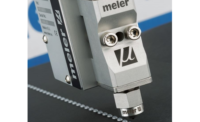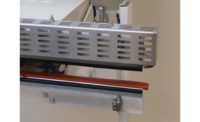Controlling the seal quality with advanced ultrasonic generators

Sealing packages with ultrasonics utilizes a vibrating tool rather than hot sealing bars. The advantage: The ultrasonic vibration forces product contamination out of the sealing zone. In addition, the ultrasonic generator can identify bags with irregularities such as folds in the seal area.
For most filling operations, products that are powdery, liquid or lumpy make it virtually impossible to avoid contaminating the seal area with product. When sealing with a traditional heat sealing system, this contamination could result in leakers in which either the seal fails in the autoclave or micro channels appear in the seal area. Bacteria or mold can then penetrate. Sealing with ultrasonics creates reliable seals even in the presence of contamination in the seal area. The ultrasonic vibrations force the product out of the sealing zone while the thermal energy required for the sealing process is produced by molecular and boundary surface friction at the interface of the two layers of film. This produces a high-strength hermetic seal between the polymer layers. When using a Herrmann Ultrasonics (herrmannultraschall.com) sealing solution, the number of leaking packages transported to the autoclave process can be reduced to almost zero. One customer recently shared actual production data that included over 5 days of production with close to 600,000 bags produced with the following impressive result: 100% tightly sealed head seams were achieved using ultrasonics.
Ultrasonic generator rejects bags with folds
The generator not only produces the vibrational energy, it also utilizes a closed loop feedback seal quality monitoring system that continually records and evaluates important sealing parameters. This closed loop monitoring system is essential when the potential for product contamination in the seal area is present. More than twenty measured values such as voltage, current, amplitude and other resultant factors are recorded and processed 10,000 times per second during the ultrasonic sealing process. This real-time feedback allows for the sealing process to be monitored and optimized on a continual basis. To ensure seal quality, each seal is compared with pre-set requirements. If the seal is not within the defined quality limits, the generator provides outputs through communication protocols to the packaging machine control system and the bags are automatically sorted. The generator's high-precision measuring system, with temperature drift compensation can detect the following error states:
• Folds in the head area
• High percentage of contamination in the seal area
• Overfilling
• Incorrect positioning within the sealing station
• Missing bags
• Miss picks or multiple bags at once
Short process times
Ultrasonic sealing exhibits a high level of energy efficiency because energy is only needed during the actual sealing process and power is only briefly delivered with typical cycle times being between 80 and 200ms. Unlike traditional heat seal systems, ultrasonic systems are ready for use as soon as the ultrasonic generator is switched on. Setup and changeover times are optimized because the typical temperature ramp up and cooling cycles do not apply. A number of different parameter sets for each product type can be stored as programs in the ultrasonic generator's memory. Automatic recipe “on the fly” switch-over is therefore possible and takes effect the next time the sealing process is initiated – no machine downtime or cycle stop is necessary.
Ultrasonics as OEM or retrofit?
Both are possible. As a specialist in ultrasonic welding technology, Herrmann Ultrasonics has developed integration guidelines and works directly with well-known manufacturers of packaging machines. To ensure the specific introduction of the ultrasonic energy at the proper time during the sealing process, the packaging machines must satisfy rigorous requirements. These requirements include the quality of the guiding components, the parallelism of the sealing tools and the consistency and adjustability of the sealing build-up force.
Ultrasonic sealing systems require a higher initial capital investment compared to heat sealing systems. The key to a short ROI when investing in ultrasonics is the overall reduction in the number of seal leakers, which will result in increased product throughput and decreased product rework. Ideally, this should be better than 1 in 10,000 bags. Ultrasonics can achieve this and usually pays for itself within 6 to 18 months. Also, overall packaging material is reduced and more importantly, the costs associated with quality control and the management of rejects is also reduced. The TCO (Total Cost of Ownership), which plays an increasingly important role in purchasing decisions, is significantly reduced.
Ultrasonic welding is a fast and very efficient method for sealing flexible packaging materials. Electrical voltage is converted into mechanical vibrations at an ultrasonic frequency of between 20 kHz and 35 kHz and transferred to the film using a welding tool known as a sonotrode. 20 kHz means 20,000 cycles per second. The packaging material is literally welded together by the heat produced from the friction that is created by the ultrasonic system. The anvil or sonotrode contour focuses the energy; efficiently melting and bonding the material. The contact surface on the anvil defines the pattern and configuration of the final seal.
Looking for a reprint of this article?
From high-res PDFs to custom plaques, order your copy today!





